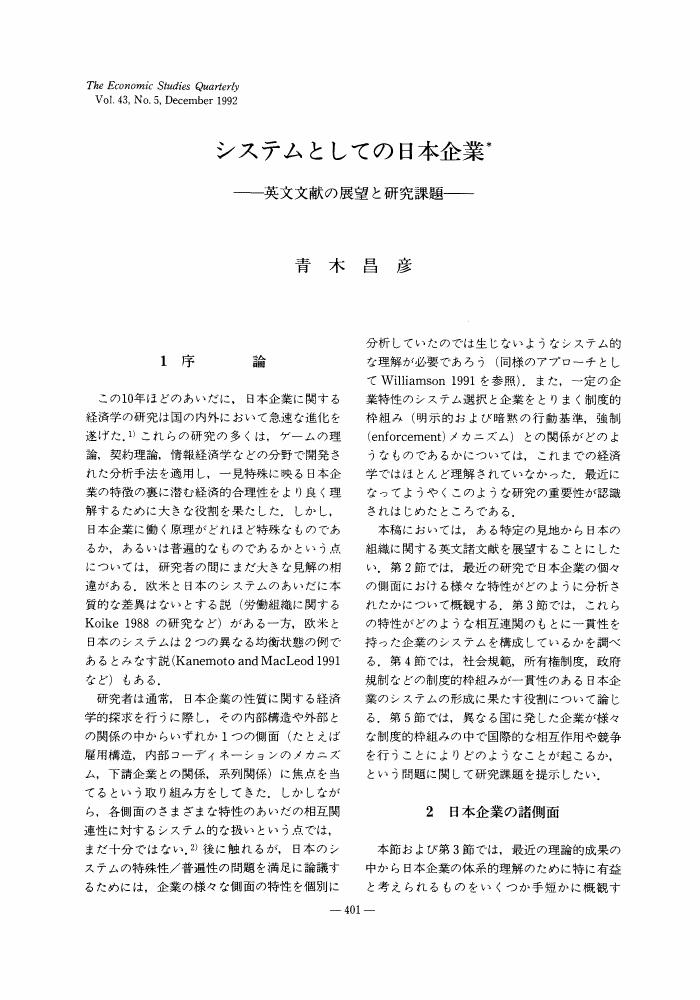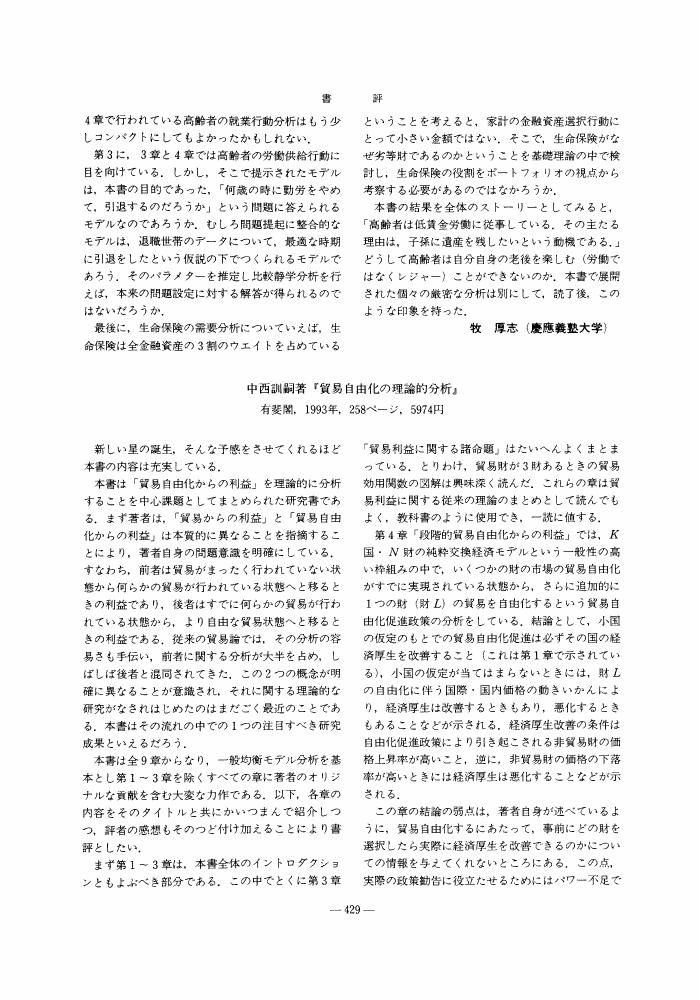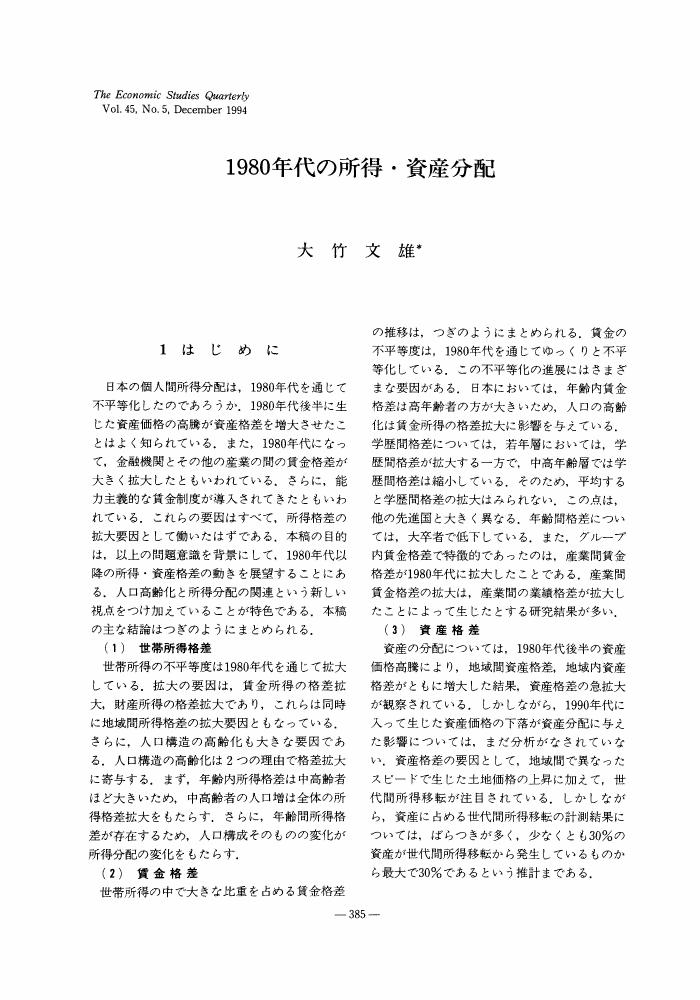30 0 0 0 OA 内生的経済成長理論
- 著者
- 柴田 章久
- 出版者
- 日本経済学会
- 雑誌
- The Economic Studies Quarterly (ISSN:0557109X)
- 巻号頁・発行日
- vol.44, no.5, pp.385-401, 1993-12-24 (Released:2007-10-19)
- 参考文献数
- 76
4 0 0 0 OA システムとしての日本企業 英文文献の展望と研究課題
- 著者
- 青木 昌彦
- 出版者
- 日本経済学会
- 雑誌
- The Economic Studies Quarterly (ISSN:0557109X)
- 巻号頁・発行日
- vol.43, no.5, pp.401-418, 1992-12-25 (Released:2008-02-28)
- 参考文献数
- 66
4 0 0 0 OA 竹下税制改革の厚生分析
- 著者
- 本間 正明 跡田 直澄 橋本 恭之
- 出版者
- 日本経済学会
- 雑誌
- The Economic Studies Quarterly (ISSN:0557109X)
- 巻号頁・発行日
- vol.40, no.4, pp.336-348, 1989-12-20 (Released:2007-10-19)
- 参考文献数
- 14
The Japanese Tax Reform Act enforced by the Takeshita Administration consists of cutting the income tax with simplification of tax rate structure and introducing the “so-called” shohi zei which is a special type of the value added tax. In general, the tax reform has great influence on the structure of tax burden among different income groups. Unfortunately, however, there have been no welfare analysis on household behavior resulting from the present tax reform in Japan. Motivated by the present stage of the study, this paper aims to develop welfare analysis which is concerned with the response of household to the change in tax structure and with its implications from the view point not only of allocation but also of distribution.The first step of our analysis is to specify respective utility functions as nested C.E.S. type for income decile groups by using Annual Report on the Family Income and Expenditure Survey. The second one is to investigate the change in consumption, saving and labour supply of different income groups due to that in tax structure by simulating the optimal behavior of respective income groups. The third step is to calculate the changes in the after-tax income and utility levels of each income group. The final one is to evaluate welfare implications of the tax reform by adopting special type of social welfare function and the generalized entropy measure for income distribution. To sum up, the present tax reform in Japan reduces tax burden and improves utility level for all income groups expect for the lowest income group. How we evaluate this consequence in welfare aspect depends upon our value judgement on social justice. If we have strong preference to equality, the resulting consequence is not welcomed to the society as a whole not only in social welfare level but also in inequality measure. On the contrary, under such circumstance as utilitarian calculus, it is proved to be favorable for the society.
- 著者
- ERICH PAUER
- 出版者
- JAPANESE ECONOMIC ASSOCIATION
- 雑誌
- The Economic Studies Quarterly (ISSN:0557109X)
- 巻号頁・発行日
- vol.38, no.4, pp.354-371, 1987-12-20 (Released:2008-02-28)
- 参考文献数
- 33
3 0 0 0 OA 斎藤光雄著「国民経済計算」創文社,1991年,viii+379ページ,定価3914円
- 著者
- 倉林 義正
- 出版者
- 日本経済学会
- 雑誌
- The Economic Studies Quarterly (ISSN:0557109X)
- 巻号頁・発行日
- vol.43, no.5, pp.423-424, 1992-12-25 (Released:2008-02-28)
2 0 0 0 OA 資本•階級•搾取 選択理論的アプローチ
- 著者
- 荻沼 隆
- 出版者
- 日本経済学会
- 雑誌
- The Economic Studies Quarterly (ISSN:0557109X)
- 巻号頁・発行日
- vol.39, no.2, pp.160-173, 1988-06-20 (Released:2007-10-19)
- 参考文献数
- 15
In this paper, we have the following results. (1) In general, the correspondeces between capital and class, and capital and exploitation don't hold in our model (these relations hold in Roemer (1982)), but the correspondence between class and exploitation holds. (2) We have two examples of nonexistence of exploitation with positive profit (the counter-example of Fundamental Marxian Theorem in our model) and an example of existence of exploitation with identical capital endowments. (3) We get some propositions about the relationship between three concepts, free to choose, freedom to attain one's purpose and non-existence of exploitation.
2 0 0 0 OA コーホート•データによる消費のライフサイクル仮説の検証
- 著者
- 成田 淳司
- 出版者
- 日本経済学会
- 雑誌
- The Economic Studies Quarterly (ISSN:0557109X)
- 巻号頁・発行日
- vol.42, no.1, pp.62-71, 1991-03-20 (Released:2007-10-19)
- 参考文献数
- 20
It is widely held that the life-cycle hypothesis of consumption is not accepted by Japanese data. However, this view is not founded on firm evidence. In this paper, the life-cycle hypothesis of consumption is tested using cohort data instead of cross-section data. Consumption function of Ghez-Becker type is applied to our data. The hypothesis is proven to be accepted.
2 0 0 0 OA ON BIG BOSS GAMES
- 著者
- SHIGEO MUTO MIKIO NAKAYAMA JOS POTTERS STEF TIJS
- 出版者
- JAPANESE ECONOMIC ASSOCIATION
- 雑誌
- The Economic Studies Quarterly (ISSN:0557109X)
- 巻号頁・発行日
- vol.39, no.4, pp.303-321, 1988-12-20 (Released:2007-10-19)
- 参考文献数
- 18
2 0 0 0 予想貨幣賃金率と投資決定:ケインズ投資モデルの再考
- 著者
- 鷲田 豊明 置塩 信雄
- 出版者
- JAPANESE ECONOMIC ASSOCIATION
- 雑誌
- The Economic Studies Quarterly (ISSN:0557109X)
- 巻号頁・発行日
- vol.38, no.3, pp.212-222, 1987
Contrary to the static theories of investment, Keynes stated in the General Theory that the reduction of expected money-wage-rates in the future would reduce the investment in quantity. This assertion, however, cannot be supported by the Neo-classical theories such as Jorgenson models or adjustment models of investment. We construct his model described in the General Theory. The main character is that the models have the capital equipment with finite operating periods. Certainly, his models support the assertion in the simplest case. Moreover, we can see that more generalized models do not necessarily support them.
2 0 0 0 予想貨幣賃金率と投資決定:ケインズ投資モデルの再考
- 著者
- 鷲田 豊明 置塩 信雄
- 出版者
- JAPANESE ECONOMIC ASSOCIATION
- 雑誌
- The Economic Studies Quarterly (ISSN:0557109X)
- 巻号頁・発行日
- vol.38, no.3, pp.212-222, 1987
Contrary to the static theories of investment, Keynes stated in the General Theory that the reduction of expected money-wage-rates in the future would reduce the investment in quantity. This assertion, however, cannot be supported by the Neo-classical theories such as Jorgenson models or adjustment models of investment. We construct his model described in the General Theory. The main character is that the models have the capital equipment with finite operating periods. Certainly, his models support the assertion in the simplest case. Moreover, we can see that more generalized models do not necessarily support them.
1 0 0 0 OA 河合正弘著「国際金融論」東京大学出版会,1994年,xii+438ページ,4326円
- 著者
- 柴田 章久
- 出版者
- 日本経済学会
- 雑誌
- The Economic Studies Quarterly (ISSN:0557109X)
- 巻号頁・発行日
- vol.45, no.5, pp.426-427, 1994-12-26 (Released:2008-02-28)
- 著者
- 牧 厚志
- 出版者
- 日本経済学会
- 雑誌
- The Economic Studies Quarterly (ISSN:0557109X)
- 巻号頁・発行日
- vol.45, no.5, pp.427-429, 1994-12-26 (Released:2008-02-28)
1 0 0 0 OA 中西訓嗣著「貿易自由化の理論的分析」有斐閣,1993年,258ページ,5974円
- 著者
- 福島 隆司
- 出版者
- 日本経済学会
- 雑誌
- The Economic Studies Quarterly (ISSN:0557109X)
- 巻号頁・発行日
- vol.45, no.5, pp.429-431, 1994-12-26 (Released:2008-02-28)
- 著者
- 藤木 裕
- 出版者
- 日本経済学会
- 雑誌
- The Economic Studies Quarterly (ISSN:0557109X)
- 巻号頁・発行日
- vol.45, no.5, pp.431-433, 1994-12-26 (Released:2008-02-28)
- 著者
- 高木 信二
- 出版者
- 日本経済学会
- 雑誌
- The Economic Studies Quarterly (ISSN:0557109X)
- 巻号頁・発行日
- vol.45, no.5, pp.433-434, 1994-12-26 (Released:2008-02-28)
- 著者
- 岡村 誠
- 出版者
- 日本経済学会
- 雑誌
- The Economic Studies Quarterly (ISSN:0557109X)
- 巻号頁・発行日
- vol.45, no.5, pp.434-437, 1994-12-26 (Released:2008-02-28)
- 参考文献数
- 3
- 著者
- KAZUMITSU NAWATA
- 出版者
- JAPANESE ECONOMIC ASSOCIATION
- 雑誌
- The Economic Studies Quarterly (ISSN:0557109X)
- 巻号頁・発行日
- vol.45, no.4, pp.339-346, 1994-12-20 (Released:2007-10-19)
- 参考文献数
- 10
In recent economic studies, Tobit models, in which the dependent variables cannot be negative, have been widely used. Although these models are usually estimated by the Tobit Maximum Likelihood Estimator (Tobit MLE), the Tobit MLE is not robust with respect to heteroskedasticity and non-normality of the error terms.Powell (1984) proposed a modified least absolute deviations estimator which is consistent under heteroskedasticity and non-normality. One of the major problems with Powell's estimator is its computational difficulty. Nawata (1992) proposed a new algorithm which makes possible to calculate Powell's estimator. However, Nawata's method is incomplete and sometimes gives wrong results. In this paper, I modify the algorithm and evaluate Powell's estimator by the Monte Carlo experiments styled after Paarsch (1984).
- 著者
- KAZUHIKO MIKAMI KEIZO MIZUNO
- 出版者
- JAPANESE ECONOMIC ASSOCIATION
- 雑誌
- The Economic Studies Quarterly (ISSN:0557109X)
- 巻号頁・発行日
- vol.45, no.4, pp.347-352, 1994-12-20 (Released:2007-10-19)
- 参考文献数
- 3
This note analyses product diversity under increasing returns to scale. We employ, in a general equilibrium framework, the model of Perloff and Salop (1985), which synthesizes Hotelling-type and Chamberlin-type models. The main result in the paper provides an instance of the excess diversity of a product, and its interpretation is illustrated diagrammatically.
1 0 0 0 OA 1980年代の所得•資産分配
- 著者
- 大竹 文雄
- 出版者
- 日本経済学会
- 雑誌
- The Economic Studies Quarterly (ISSN:0557109X)
- 巻号頁・発行日
- vol.45, no.5, pp.385-402, 1994-12-26 (Released:2008-02-28)
- 参考文献数
- 104
1 0 0 0 OA 長期的経済関係のエコノメトリックス
- 著者
- 畠中 道雄
- 出版者
- 日本経済学会
- 雑誌
- The Economic Studies Quarterly (ISSN:0557109X)
- 巻号頁・発行日
- vol.45, no.5, pp.403-418, 1994-12-26 (Released:2008-02-28)
- 参考文献数
- 42












